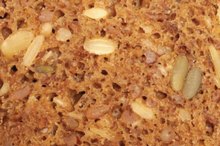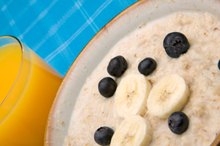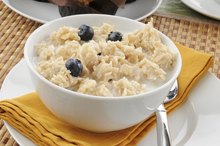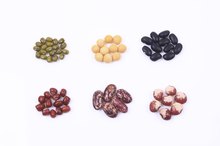Effects of Oatmeal on Blood Glucose
Whether you've been diagnosed with type I or type II diabetes, chances are you're facing the same challenges: how to manage your blood glucose levels and reduce your weight. Fortunately, there are a number of easy, effective ways to manage both, and they don't require a lot of expense, time or energy. It all starts at the breakfast table.
Blood Glucose and Hyperglycemia
The challenge for most diabetics is how to manage their blood glucose levels. The normal range of blood sugar is 70 to 110 mg/dl. While glucose levels can fluctuate throughout the day, blood sugar levels that remain over 110 to 130 mg/dl can mean that you are pre-diabetic--a dangerous disease that affects the kidneys, heart, eyes and many other organs. Newly diagnosed diabetics learn that one of the most important ways to manage blood glucose is by eating complex carbohydrates--carbohydrates that break down slowly in the bloodstream, preventing blood glucose levels from spiking.
The Glycemic Index
List of Low-Glycemic & High-Protein Snack Foods
Learn More
One of the easiest ways to manage your blood glucose is to eat foods that rate low on the glycemic index. The glycemic index (GI) is a rating system that is assigned to all carbohydrates and defines how quickly they cause blood glucose levels to spike. Spiking glucose levels can cause a number of complications in diabetes like dizziness, nausea, muscle tremors and lack of consciousness. Using the glycemic index, diabetics can choose foods that keep their blood glucose levels stable and avoid serious complications.
Foods rated lower than 54 on the GI are considered low. Foods rated between 55 and 70 are medium-GI foods. Foods rated over 70 are high GI foods. The goal is to eat low-GI foods, or combine high-GI foods with low-GI foods or fat and protein to limit blood glucose spiking. Traditional oats (also called steel cut oats) rate low at 51, so you can eat as much of them as you want.
Added Benefits
In addition to eating oats for breakfast, you can add oats to low-sugar snacks like cookies and energy bars for a low-GI treat, and even as a filler in meatloaf. Oats are also high in soluble fiber. That means that not only do they digest slowly, keeping blood sugar levels low, they also help to prevent certain types of colon cancer. Oats also help to lower low-density lipoproteins by grabbing onto them and excreting them from the body before they have an opportunity to accumulate on the inside of the coronary arteries, which can lead to a heart attack.
Related Articles
References
Resources
Writer Bio
Allen Smith is an award-winning freelance writer living in Vail, Colo. He writes about health, fitness and outdoor sports. Smith has a master's degree in exercise physiology and an exercise specialist certification with the American College of Sports Medicine at San Diego State University.









